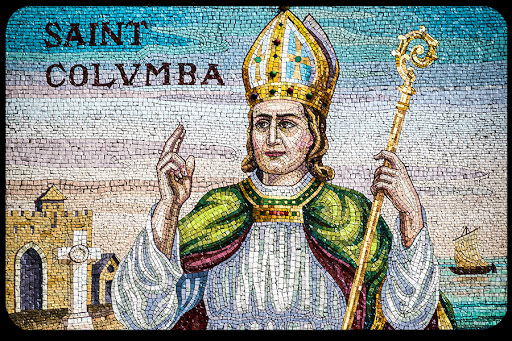The story of Scottish civilisation begins fifteen centuries ago, when a group of twelve Christian monks, led by St. Columba, set sail from Ireland to the wild coast of Scotland. The Ireland they were leaving behind was a land of civilization, stability and safety. Scotland was foreign, hostile, unstable and dangerous.
The monks’ short journey proved to have immense consequences. It radically altered the course of British history, triggering a revolution that transformed Britain from an illiterate and backward place to a land of scholarship, learning and high culture.
Columba the Banished
The group was led by Columba, or Columcille (Irish for "church dove") who had been exiled from Ireland as punishment. He’d had been accused of a breach of copyright by copying a psalter – and this dispute proved to be a deadly one, touching off a pitched battle during which many were killed.
In the aftermath, Columba was threatened with excommunication by a synod of his fellow monks, though his punishment was eventually changed to permanent exile. Columba promised to expiate his guilt and wrongdoing by winning as many souls for Christ as had perished in the battle. He agreed to be exiled to a place where he could no longer see Ireland and promised never to set foot on Irish soil again.
Visiting the King of the Gaels
When Columba and his monks made landfall, however, they weren’t yet entering territory that was completely foreign. At this time, the west coast of present day Scotland was actually part of Dalriada, an ancient Irish kingdom which straddled the sea between northeast Ireland and Scotland. The inhabitants were Irish and known as Gaels or Scots; they would eventually give their name to a new larger kingdom, Scotland. (Today, the region is known as Argyll, "Land of the Gaels.")
Immediately upon crossing the sea, Columba and his monks journeyed to meet the king at his fortified hill fort. This visit was more than just a diplomatic nicety; Columba needed the King’s permission to preach in his lands — and he needed royal protection.
Columba also required land as a base for his community of monks. The King graciously granted the pilgrims the small island of Iona, forty miles to the west.
Inspirational and Charismatic Leadership
Columba was a rising star of the Irish Church and of noble birth, descended from an Irish high king. He was a confident and hugely charismatic man; his noble background would serve him well in his mission, as his diplomacy skills would prove to be as important as the power of his faith. Under Columba’s inspirational and charismatic leadership, Iona would become one of the major powerhouses of Christian learning and culture in the whole of Europe.
Converting the Fierce Picts
Once Columba had established a thriving monastic community, he looked beyond Iona’s shores. Beyond Dalariada was the enemy territory of Pict Land and the only way to penetrate through the densely wooded mountains was by journeying through Scotland’s natural waterways of river and lochs.
The Picts were a fierce pagan Iron-Age people and Columba‘s mission was undoubtedly a dangerous one. Columba eventually arrived in Inverness in the Highlands and met with the Pictish King Bridei, ultimately winning his respect, though not his conversion.
Nevertheless, Columba and his mission would succeed in transforming the pagan Iron-Age Picts to a civilized and cultured Christian people. Interestingly, the Picts not only adopted the new Christian faith but also the Gaelic language of the Columba and his monks. This unification by faith, language and culture would eventually lay the foundations for a united kingdom of Scotland under a Christian King.
Columba and the Scottish Clans
For 1500 years the Scottish Clans of MacCallum, Malcolm and Robertson have proudly traced their ancestry to the original followers of Columba and his monks – the earliest Christians in Scotland.
Also, Clan MacKinnon are his spiritual descendants, as after Columba founded his monastery on Iona the MacKinnons provided abbots to the Church there for centuries.
The Legends of St. Columba
Columba was a great man of letters, a writer of hymns who is said to have transcribed over 300 books. There are surviving manuscripts of his in Switzerland and the British Library.
Many legends and stories are associated with him. One of the most famous involves the Loch Ness Monster, when Columba is said to have a banished a water beast to the depths of Loch Ness after it had attacked one of his party.
Columba died on Iona in 597 AD and was buried by his monks in the Abbey he had founded.
Michael Durnan has been a Catholic Primary School Teacher, in his native England, for the past 27 years but he now works as a Supply (Substitute) Teacher. He recently enrolled as a Film and TV Support Artiste and has worked in a BBC TV costume drama.This article was originally published in Regina Magazineand is reprinted here with kind permission.

